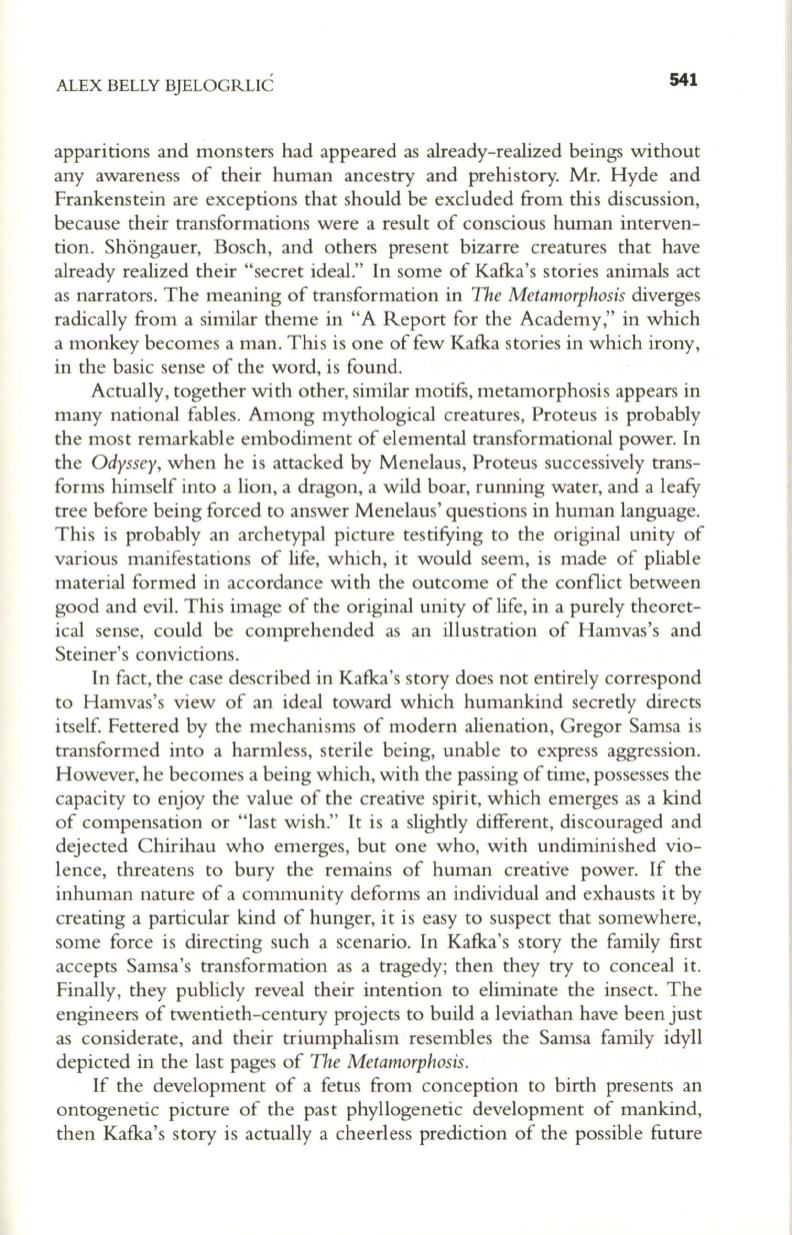
ALEX BELLY BJELOGRLIC
541
apparitions and monsters had appeared as already-realized beings without
any awareness of their human ancestry and prehistory. Mr. Hyde and
Frankenstein are exceptions that should be excluded from this discussion,
because their transformations were a result of conscious human interven–
tion. Shongauer, Bosch, and others present bizarre creatures that have
already realized their "secret ideal." In some of Kafka's stories animals act
as narrators. The meaning of transformation in
The Metamorphosis
diverges
radically from a similar theme in "A Report for the Academy," in which
a monkey becomes a man. This is one of few Kafka stories in which irony,
in the basic sense of the word, is found.
Actually, together with other, similar motifs, metamorphosis appears in
many national fables. Among mythological creatures, Proteus is probably
the most remarkable embodiment of elemental transformational power. In
the
Odyssey,
when he is attacked by Menelaus, Proteus successively trans–
forms himself into a lion, a dragon, a wild boar, running water, and a leafy
tree before being forced to answer Menelaus' questions in human language.
This is probably an archetypal picture testifying to the original unity of
various manifestations of life, which, it would seem, is made of pliable
material formed in accordance with the outcome of the conflict between
good and evil. This image of the original unity of life, in a purely theoret–
ical sense, could be comprehended as an illustration of Hamvas's and
Steiner's convictions.
In fact, the case described in Kafka's story does not entirely correspond
to Hamvas's view of an ideal toward which humankind secretly directs
itself. Fettered by the mechanisms of modern alienation, Gregor Samsa is
transformed into a harmless, sterile being, unable to express aggression.
However, he becomes a being which, with the passing of time, possesses the
capacity to enjoy the value of the creative spirit, which emerges as a kind
of compensation or "last wish."
It
is a slightly different, discouraged and
dejected Chirihau who emerges, but one who, with undiminished vio–
lence, threatens to bury the remains of human creative power. If the
inhuman nature of a community deforms an individual and exhausts it by
creating a particular kind of hunger, it is easy to suspect that somewhere,
some force is directing such a scenario. In Kafka's story the family first
accepts Samsa's transformation as a tragedy; then they try to conceal it.
Finally, they publicly reveal their intention to eliminate the insect. The
engineers of twentieth-century projects to build a leviathan have been just
as considerate, and their triumphalism resembles the Samsa family idyll
depicted in the last pages of
The Metamorphosis.
If the development of a fetus from conception to birth presents an
ontogenetic picture of the past phyllogenetic development of mankind,
then Kafka's story is actually a cheerless prediction of the possible future


